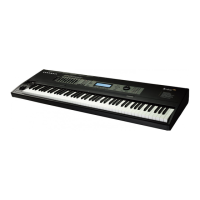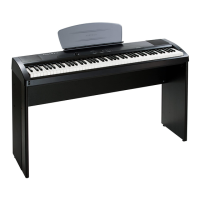3-2
Disk Partitioning
Partitioning Your Hard Disk
Note: If you happen to have a 2-G hard disk, you might wonder whether it’s worth the effort to partition
it. If you want the disk to be fully DOS/Windows-compatible, you should partition it. If DOS/Windows
compatibility isn’t important, partitioning isn’t necessary (for example, when you know you’ll never use
the hard disk with a computer).
The last partition includes whatever disk space (up to the 8-G limit) remains after the last full
2-G partition is formatted. The last partition is usually slightly less than 2 G, because each
partition contains some data for disk management. For example, if you format a new 10-G hard
disk from the K2600, you end up with three 2-G partitions, and a fourth partition of slightly
under 2 G. The K2600 doesn’t format the remaining 2 G. You may be able to use a personal
computer to format the remaining space for use with that computer. See Partitioning Large Disks
on page 3-5.
Note: There are two schools of thought about describing the size of storage devices. Some people think of a
kilobyte as 1,000 bytes, and others think of it as 1,024 bytes (which is the actual number). If you consider
a kilobyte to be 1,000 bytes, then a gigabyte is 1,000
3
, or a billion bytes. If you think of a kilobyte as 1,024
bytes (as we do), a gigabyte is 1,024
3
, or 1,073,741,824 bytes. So a 2-G partition stores about 2.15 billion
bytes, which you might prefer to think of as 2.1 G.
Doing a Hard Format
There are two kinds of formatting: we’ll call them normal formatting and “hard” formatting.
Normal formatting is what usually happens when you format a disk. Although normal
formatting makes an entire hard disk accessible for data storage, it doesn’t actually delete files;
instead, normal formatting deletes underlying system-level data about how and where the files
are stored. Although this makes the files on the disk unusable, much of the files’ contents remain
on the disk (that’s why you can often recover a file even after you’ve deleted it).
Hard formatting physically erases every bit of data on the disk. Once a disk is hard formatted,
there’s no data to recover; it’s completely blank, and must be formatted normally before it can
store data again. Hard formatting can sometimes make a corrupted disk usable, or make it easier
to use a disk on a different operating system.
The first time you format a disk for use with the K2600—whether it’s new or previously
formatted with a computer—you should begin with a hard format, then format it normally with
the K2600. (You should do this because any residual file data left by normal formatting could
cause the K2600 to miscalculate partition boundaries.)
Any time you’re using a PC or a Mac to format or reformat a disk for use with the K2600, you
should start with a hard format to remove residual file data.
When using the K2600 to reformat a disk or partition that’s been formatted with the K2600, you
can probably skip the hard format, unless you’re having problems saving and loading files.

